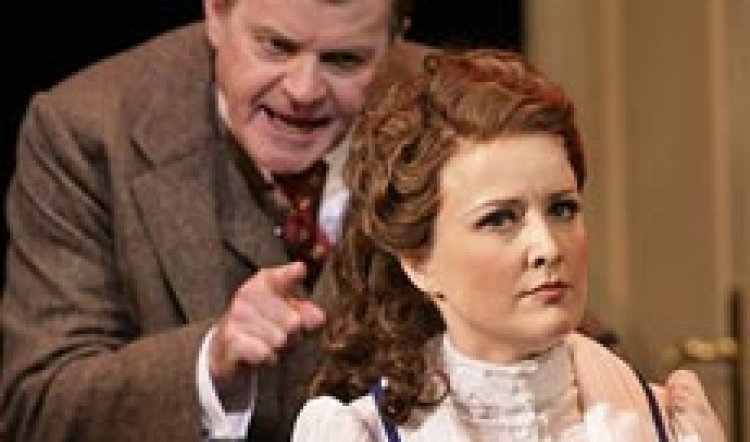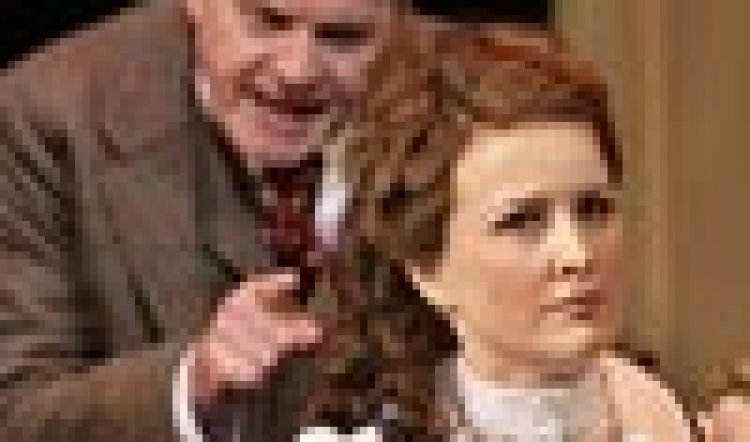
My Fair Lady
My Fair Lady Opera Australia at the Sydney Opera House and touring; for more information: www.opera-australia.org.au
SIXTY years on from its premiere on Broadway, Lerner and Loew’s My Fair Lady remains one of the theatrical phenomena of the 20th century. More than a musical, different than an opera, more too than George Bernard Shaw’s play Pygmalion, from which it was adapted, My Fair Lady is one of the most loved, best known and enduring works of music theatre ever devised. And Opera Australia’s production, under Stuart Maunder’s direction, demonstrates why that is.
The weight of its history, particularly the George Cukor/Cecil Beaton/Audrey Hepburn/Rex Harrison movie of 1964 (recently restored and re-released on DVD) is immense. To overcome or go beyond it, any new stage production must have three crucial ingredients: a top rank cast, a top rank orchestra, and a costume designer who can at once acknowledge the Cecil Beaton legacy without being intimidated by it.
Roger Kirk’s costumes are in that category. From picturesquely grimy and ragged for the undeserving poor of Covent Garden’s market community, to dazzling Edwardian opulence and lunatic race day millinery for the upper classes, the stage is awash with atmospheric colour and gorgeous outfits. They are a triumph for the OA costume and millinery workshops.
The cast is also a delight. In Taryn Fiebig, OA and music theatre in general, has a new star. She has already proved herself in the classic ingénue/up and coming roles for the company and overseas. She sharpened her acting and operetta chops as Mabel in Pirates of Penzance and now takes on the demanding role of Eliza Doolittle. It’s a big ask.
Fiebig has some of the most famous standards of music theatre to make her own in a way that is natural and not overly operatic (Wouldn’t it Be Luvverly, I Could Have Danced All Night). She has to be able to act as Eliza makes the journey from bawdy cockney guttersnipe to a young lady of poise and deeper feelings. And her singing and speaking voice must make a similar journey: from profligately dropped “haitches” and the wholesale slaughter of vowels to the refinement of the drawing room. Finally – and quite frankly – she has to look really good. Feibig does it all with a stirring mix of panache and sweetness.
Reg Livermore’s Professor Henry Higgins is also a fascinating mixture. On the surface there’s insufferable pomp and irascibility, lurking beneath is the unconscious and almost unwilling charm that makes Eliza’s growing attachment to him far more plausible than usual. His delivery of the patter songs originally devised for the non-singing Rex Harrison is perfect and he quickly banishes any lingering memory of that horrid old misogynist.
 Higgins's foil, tubby, obtuse Colonel Pickering is brought to bumbling, twinkling life by Rhys McConnochie. Divine Nancye Hayes plays the redoubtable Mrs Higgins, long-suffering mother of Henry. What she doesn’t know about how to indicate hauteur, humanity and humour through the tiniest lift of chin or eyebrow isn’t worth knowing.
Higgins's foil, tubby, obtuse Colonel Pickering is brought to bumbling, twinkling life by Rhys McConnochie. Divine Nancye Hayes plays the redoubtable Mrs Higgins, long-suffering mother of Henry. What she doesn’t know about how to indicate hauteur, humanity and humour through the tiniest lift of chin or eyebrow isn’t worth knowing.

Robert Grubb, as Eliza’s dreadful father Alfred P Doolittle, is an electric stage presence. He is boisterous, obnoxious and, as a philosopher who understands only too well that morals are for those who can afford them, he is one of the stand-outs in a company of stand-outs.
Music theatre rising star Matthew Robinson causes hearts of all persuasions to pitter-pat when, as Freddy – clad in debonair white tie and tails – he launches into On The Street Where You Live. Rarely has an upper class twit been so sweetly lovesick, handsome and irresistible.
The magnificent Adele Johnson is Mrs Pearce, the formidable housekeeper-nanny who keep the Higgins-Pickering-Doolittle ménage respectable and in order. She also makes a brief but telling appearance at the Ball as the Grand Duchess of somewhere eastern European, but as Mrs Pearce she is splendid.
Choreographer Elizabeth Hill does a grand job of the dance numbers, from the oompah knees-ups of Covent Garden, to the stately gavotte and polkas of the nobs’ cavortings. And dialect coach Jenny Kent has accomplished linguistic miracles that would impress even pedantic Prof Higgins. Accents from cockney to toff are secure and convincing, so when Eliza finally manages the transition from “the rine in Spine” to “the rein in Spein” it is a fabulous moment matched only by Colonel Pickering’s vowels which out-pomp Prince Charles in the “trizers” department.
Richard Roberts’ revolving multiple destination set (Covent Garden, the pub, Mrs Higgins’ conservatory, Ascot, a ballroom, the Wimpole Street house – three views – inside and out) works well in the main and is very smart given that it has to travel. Its only significant failing is the ballroom scene where the entrances and set-up of the dance crowd are confused and detract from the impact Eliza is supposed to make.
That quibble aside, this production of My Fair Lady is a smart bit of popular programming and artistic excellence. It‘s carried along on the music by the precision and seeming joyousness of the Opera and Ballet Orchestra (Andrew Greene conducting) and the faith of ticket purchasers in their investment is not displaced. It’s reely luvverly an’ at’s ve troof.



